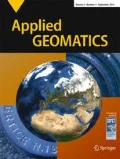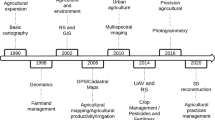Abstract
There has been increased interest in mobile mapping system (MMS) usage, especially in the surveying and implementation of projects, for engineering and planning applications. Moreover, it is needed to enable state-of-the-art technologies implementation and usage in both modern and old (i.e., already existing) projects, especially when they are executed at sites with difficult nature and those located in crowded cities. The design of engineering projects consists of three phases: conceptual, preliminary, and detailed design phases. Surveying and site design is one of the most important parts in all these phases, in both the planning and implementation of infrastructure engineering and its layout. Examples are numerous and sometimes they are the fine line in the design and decision of the implementation of some projects, such as in roads rehabilitation, drainage networks, and railway and metro installation. The critical issue in such projects is the required accuracy, which should be achieved and guaranteed. Then, more applications and new practical and easily applied methodologies are needed. To achieve the accuracy required, we propose an effective methodology using an MMS and some software to check and guarantee that the target is met. We present an application of the methodology and a discussion of the problems faced while employing the MMS methodology. Two important projects are highlighted as case studies of our methodology application in employing an MMS in the surveying design phase of important scale infrastructures in the Kingdom of Saudi Arabia (KSA). The first is the surveying for the design of 180 km of drainage system in Jeddah and the second is the surveying of 1500 km of an existing railway network. The two surveying projects are the first applications using an MMS in the KSA where the accuracy was a necessity for the purpose of state-of-the-art management and monitoring of new and old installed systems. In this work, we discuss the new technology application and the problems faced. In addition, we address the different applications covered by an MMS.



















Similar content being viewed by others
References
Cheng W, Hassan T, El-Sheimy N, Lavigne M (2008) Automatic road vector extraction for mobile mapping systems. Int Arch Photogramm Remote Sens 37(Part B3b):515–521
El-Sheimy N (2005) An overview of mobile mapping systems. In: Proceedings of the FIG Working Week 2005 and the 8th International Conference for Global Spatial Data Infrastructure (GSDI-8), Cairo, Egypt, 16–21 April 2005
El-Sheimy N, Schwarz KP (1999) Navigating urban areas by VISAT—a mobile mapping system integrating GPS/INS/digital cameras for GIS applications. NAVIGATION, Journal of the Institute of Navigation 45(4):275–286
Jaakkola A, Hyyppä J, Hyyppä H, Kukko A (2008) Retrieval algorithms for road surface modelling using laser-based mobile mapping. Sensors 8:5238–5249. https://doi.org/10.3390/s8095238
Kremer J, Hunter G (2007) Performance of the StreetMapper Mobile LiDAR Mapping System in real world projects. In: Proceedings of Photogrammetric Week 2007, Stuttgart, Germany, pp 215–225
Kumar P, McElhinney CP, Lewis P, McCarthy T (2014) Automated road markings extraction from mobile laser scanning data. Int J Appl Earth Obs Geoinf 32:125–137
Landa J, Prochazka D (2014) Automatic road inventory using LiDAR. Procedia Econ Financ 12:363–370
Petrie G (2010) An introduction to the technology: mobile mapping systems. Geoinformatics 13:32–43
Puente I, González-Jorge H, Martínez-Sánchez J, Arias P (2013) Review of mobile mapping and surveying technologies. Measurement 46(7):2127–2145
Sairam N, Nagarajan S, Ornitz S (2016) Development of mobile mapping system for 3D road asset inventory. Sensors 16:367. https://doi.org/10.3390/s16030367
Schwarz KP, El-Sheimy N (2007) Smart mobile mapping systems—state of the art and future trends. In: Tao CV, Li J (eds) Advances in mobile mapping technology. ISPRS Book Series, Vol. 4. Taylor & Francis, London. ISBN 978-0-415-42723-4
Schwarz KP, El-Sheimy N (2012) Mobile mapping systems—state of the art and future trends. Int Arch Photogramm Remote Sens Spat Inf Sci 35:759–768
Shiu W, Tam KB (2012) Evaluation of mobile mapping system (MMS) survey for public housing estates in Hong Kong. In: FIG Working Week 2012, Knowing to manage the territory, protect the environment, evaluate the cultural heritage, Rome, Italy, 6–10 May 2012. Available online at: https://www.fig.net/resources/proceedings/fig_proceedings/fig2012/papers/ts03d/TS03D_shiu_tam_6094.pdf
Slattery KT, Slattery DK, Peterson JP (2012) Road construction earthwork volume calculation using three-dimensional laser scanning. J Surv Eng 138(2):96–99
Soininen A (2015) TerraMatch user’s guide. Terrasolid software. Available online at: http://www.terrasolid.com/download/tmatch.pdf. Accessed 6 Nov 2017
Sun H, Wang C, El-Sheimy N (2011) Automatic traffic lane detection for mobile mapping systems. In: Proceedings of the 2011 International Workshop on Multi-Platform/Multi-Sensor Remote Sensing and Mapping, Xiamen, China, 10–12 January 2011
Tao CV (2000) Mobile mapping technology for road network data acquisition. J Geospat Eng 2:1–14
Tao CV, Li J (eds) (2007) Advances in mobile mapping technology. ISPRS Book Series, Vol. 4. Taylor & Francis, London, 176 pp. ISBN 978-0-415-42723-4
Toschi I, Rodríguez-Gonzálvez P, Remondino F, Minto S, Orlandini S, Fuller A (2015) Accuracy evaluation of a mobile mapping system with advanced statistical methods. The International Archives of the Photogrammetry, Remote Sensing and Spatial Information Sciences, Volume XL-5/W4, 2015 3D Virtual Reconstruction and Visualization of Complex Architectures, 25–27 February 2015, Avila, Spain, pp 245–253. https://doi.org/10.5194/isprsarchives-XL-5-W4-245-2015. Available online at: https://www.int-arch-photogramm-remote-sens-spatial-inf-sci.net/XL-5-W4/245/2015/isprsarchives-XL-5-W4-245-2015.pdf
Wygant CA (2009) User tests of the Optech LYNX Mobile Mapping system, data QC to ground survey control. In: Proceedings of the ASPRS 2009 Annual Conference, Baltimore, Maryland, 9–13 March 2009. https://www.asprs.org/a/publications/proceedings/baltimore09/0104.pdf
Zhang K, Xiao B (2003) GPS and mobile multisensor mapping system. Wuhan Univ J Nat Sci 8(2B):557–565
Author information
Authors and Affiliations
Corresponding author
Rights and permissions
About this article
Cite this article
Al-Bayari, O. Mobile mapping systems in civil engineering projects (case studies). Appl Geomat 11, 1–13 (2019). https://doi.org/10.1007/s12518-018-0222-6
Received:
Accepted:
Published:
Issue Date:
DOI: https://doi.org/10.1007/s12518-018-0222-6




